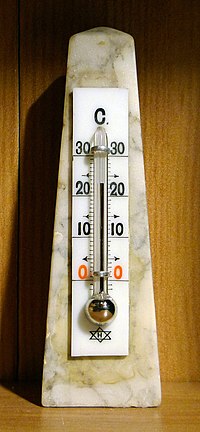
Photo from wikipedia
OBJECTIVE To investigate a probable impact of seasons on the diagnosis of GDM, as well as the specific effect of the environmental temperature on the diagnosis of this clinical entity.… Click to show full abstract
OBJECTIVE To investigate a probable impact of seasons on the diagnosis of GDM, as well as the specific effect of the environmental temperature on the diagnosis of this clinical entity. PATIENTS AND METHODS Two observational studies, one retrospective and one prospective, were conducted in a referral center. Study A included retrospectively 7618 pregnant women who underwent a 3-h 100 g OGTT during the 3rd trimester of gestation. Study B prospectively included 768 pregnant women tested in the 3rd trimester of gestation with a 75 g OGTT. Temperature was recorded every day at 09:00 h. RESULTS Retrospective Study A: GDM prevalence differed significantly by season: winter = 28.1%, summer = 39.2%, spring = 32.4% and autumn = 32.4% (P < 0.0001). The odds ratio for being diagnosed with GDM was much higher during summer 1.65 (95% CI: 1.43-1.90), with spring and autumn following with 1.23 (95% CI: 1.08-1.39) compared to winter. Glucose levels during OGTT were measured: significantly increased blood glucose values were observed at 60, 120 and 180 min in summer, which remained significant after adjustment for age, gestational age, BMI, weight gain during pregnancy and blood pressure. Prospective Study B: At temperatures above 25°C, the average glucose 60-min and 120-min levels were increased. The relative risk for abnormal glucose values at 60 min, when the environmental temperature increased over 25°C, was 2.2 (1.5-3.3). CONCLUSIONS GDM prevalence in Greece presents seasonal variation, with higher risk during summer due to post glucose load level variations. These variations could be attributed to differences in environmental temperature.
Journal Title: European journal of endocrinology
Year Published: 2018
Link to full text (if available)
Share on Social Media: Sign Up to like & get
recommendations!